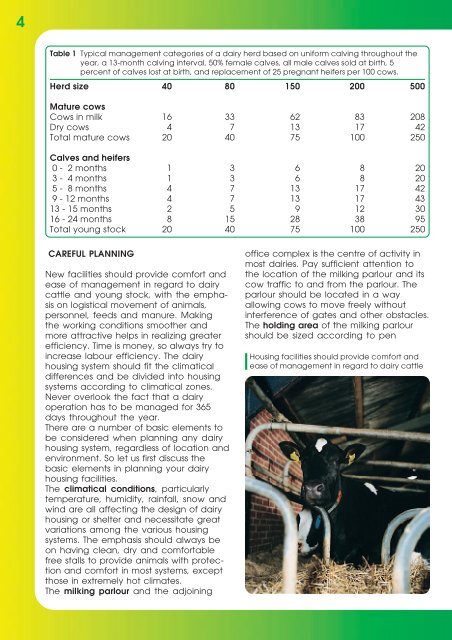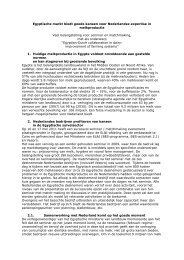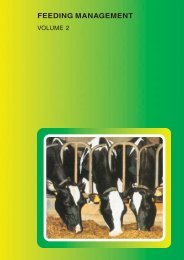DAIRY HOUSING MANAGEMENT - Veepro Holland
DAIRY HOUSING MANAGEMENT - Veepro Holland
DAIRY HOUSING MANAGEMENT - Veepro Holland
Create successful ePaper yourself
Turn your PDF publications into a flip-book with our unique Google optimized e-Paper software.
4<br />
Table 1 Typical management categories of a dairy herd based on uniform calving throughout the<br />
year, a 13-month calving interval, 50% female calves, all male calves sold at birth, 5<br />
percent of calves lost at birth, and replacement of 25 pregnant heifers per 100 cows.<br />
Herd size<br />
40<br />
80<br />
150<br />
200<br />
500<br />
Mature cows<br />
Cows in milk<br />
Dry cows<br />
Total mature cows<br />
Calves and heifers<br />
0 - 2 months<br />
3 - 4 months<br />
5 - 8 months<br />
9 - 12 months<br />
13 - 15 months<br />
16 - 24 months<br />
Total young stock<br />
CAREFUL PLANNING<br />
16<br />
4<br />
20<br />
1<br />
1<br />
4<br />
4<br />
2<br />
8<br />
20<br />
New facilities should provide comfort and<br />
ease of management in regard to dairy<br />
cattle and young stock, with the emphasis<br />
on logistical movement of animals,<br />
personnel, feeds and manure. Making<br />
the working conditions smoother and<br />
more attractive helps in realizing greater<br />
efficiency. Time is money, so always try to<br />
increase labour efficiency. The dairy<br />
housing system should fit the climatical<br />
differences and be divided into housing<br />
systems according to climatical zones.<br />
Never overlook the fact that a dairy<br />
operation has to be managed for 365<br />
days throughout the year.<br />
There are a number of basic elements to<br />
be considered when planning any dairy<br />
housing system, regardless of location and<br />
environment. So let us first discuss the<br />
basic elements in planning your dairy<br />
housing facilities.<br />
The climatical conditions, particularly<br />
temperature, humidity, rainfall, snow and<br />
wind are all affecting the design of dairy<br />
housing or shelter and necessitate great<br />
variations among the various housing<br />
systems. The emphasis should always be<br />
on having clean, dry and comfortable<br />
free stalls to provide animals with protection<br />
and comfort in most systems, except<br />
those in extremely hot climates.<br />
The milking parlour and the adjoining<br />
33<br />
7<br />
40<br />
3<br />
3<br />
7<br />
7<br />
5<br />
15<br />
40<br />
62<br />
13<br />
75<br />
6<br />
6<br />
13<br />
13<br />
9<br />
28<br />
75<br />
83<br />
17<br />
100<br />
8<br />
8<br />
17<br />
17<br />
12<br />
38<br />
100<br />
208<br />
42<br />
250<br />
20<br />
20<br />
42<br />
43<br />
30<br />
95<br />
250<br />
office complex is the centre of activity in<br />
most dairies. Pay sufficient attention to<br />
the location of the milking parlour and its<br />
cow traffic to and from the parlour. The<br />
parlour should be located in a way<br />
allowing cows to move freely without<br />
interference of gates and other obstacles.<br />
The holding area of the milking parlour<br />
should be sized according to pen<br />
Housing facilities should provide comfort and<br />
ease of management in regard to dairy cattle





